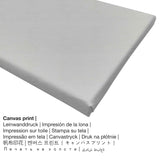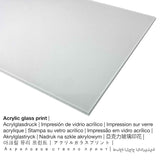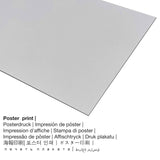Jules Tavernier, 1878 - Ịgba egwu na Roundhouse dị n'okpuru ala na Clear Lake, California - ọmarịcha nka.
Ụtụ gụnyere. Mbupu gbakọrọ na ndenye ọpụpụ.
Họrọ ngwa ngwaahịa ị ga-atụkwasị n'ụlọ gị
Maka mbipụta nka ọ bụla anyị na-enye ihe dị iche iche na nha. Anyị na-ahapụ gị ka ịhọrọ nha na akụrụngwa ọkacha mmasị gị n'etiti nhọrọ nhazi ngwaahịa ndị a:
- Kwaaji: A printed canvas stretched on a wood frame. The advantage of canvas prints is that they are relatively low in weight. This means, it is quite simple to hang the Canvas print without the help of extra wall-mounts. A canvas print is suited for any type of wall.
- Mpempe akwụkwọ (ihe kwaaji): Our poster print is a UV printed canvas paper with a fine structure on the surface. Please bear in mind, that depending on the absolute size of the canvas poster print we add a white margin 2-6 cm round about the work of art, which facilitates the framing with your custom frame.
- Aluminom ihe eji eme ihe: An Aluminium Dibond print is a material with an outstanding depth. For your Direct Aluminium Dibond option, we print the selected artwork right onto the surface of the aluminum.
- Glass acrylic e biri ebi (nwere ezigbo mkpuchi iko): The print on acrylic glass, which is sometimes described as a an art print on plexiglass, will transform the original into décor. The great upside of an acrylic glass art print is that contrasts plus color details will be identifiable because of the very fine gradation.
Nkwupụta iwu: We try all that we can to describe the art products in as much detail as possible and to illustrate them visually. Although, the tone of the printing material, as well as the imprint may differ slightly from the image on your device's screen. Depending on your screen settings and the nature of the surface, not all colors are printed 100% realistically. Since all the are printed and processed by hand, there might also be minor differences in the exact position and the size of the motif.
Nkọwa ihe osise izizi sitere na webụsaịtị ihe ngosi nka (© Nwebiisinka - nke Ụlọ ihe ngosi nka nke Obodo ukwu - Museumlọ ihe ngosi nka nke Obodo)
Parisian-trained artist Jules Tavernier settled in San Francisco, in the 1870s, where he received his most important commission from Tiburcio Parrott, the city’s leading banker. During a visit from his Parisian business partner Baron Edmond de Rothschild, in 1876, Parrott was able to obtain entry to a sacred ritual in the Pomo Indian’s underground roundhouse at Clear Lake, north of San Francisco. The two men were in the process of acquiring the mineral rich lands of the Pomo Indians, which the tribe had inhabited for generations.Tavernier spent two years working on this recently discovered masterwork, creating a composition of nearly one hundred figures, including two young Pomo male dancers, who, surrounded by the tribe and the white visitors, including Parrott and Rothschild, act out a coming of age ritual. Tavernier renders the light illuminating the dimly lit interior with brilliant technical finesse by means of highly controlled tonal variation and flashes of color to enliven the scene. Upon its completion, Parrott presented the painting to Rothschild, where it remained in their family until present time. The painting captures the very moment when white settlers laid claim to the Pomo lands.
Kedu ụdị ngwaahịa anyị na-eweta ebe a?
The 19th narị afọ masterpiece was made by the male American artist Jules Tavernier. A na-ese ihe osise ahụ na nha: 48 × 72 1/4 na (121,9 × 183,5 cm) and was painted with the medium oil on canvas. Today, this piece of art forms part of the art collection of Museumlọ ihe ngosi nka nke Obodo. With courtesy of - The Metropolitan Museum of Art, New York, Marguerite and Frank A. Cosgrove Jr. Fund, 2016 (licensed: public domain). : Marguerite and Frank A. Cosgrove Jr. Fund, 2016. Besides, the alignment of the digital reproduction is odida obodo n'akụkụ akụkụ nke 16: 9, nke pụtara na ogologo bụ 78% ogologo karịa obosara. The painter Jules Tavernier was a North American artist from United States, whose style can mainly be assigned to Romanticism. The North American artist lived for 45 years and was born in 1844 na Paris, Ile-de-France, France wee nwụọ na 1889.
Data ndabere gbasara nka
| Aha ọrụ nka: | "Dance in a Subterranean Roundhouse at Clear Lake, California" |
| Nhazi nke ọrụ nka: | sere |
| Category: | nkà nke oge a |
| Century: | 19th narị afọ |
| Ekepụtara: | 1878 |
| Afọ nka: | 140 afọ |
| Usoro nka izizi: | mmanụ na kwaaji |
| Ogo nke ọrụ nka izizi: | 48 × 72 1/4 na (121,9 × 183,5 cm) |
| Egosiputara na: | Museumlọ ihe ngosi nka nke Obodo |
| Ebe ngosi nka: | New York City, New York, Njikota Obodo Amerika |
| Weebụsaịtị ihe ngosi nka: | Museumlọ ihe ngosi nka nke Obodo |
| Akwụkwọ ikike nka: | ngalaba ọha |
| Site n'aka: | The Metropolitan Museum of Art, New York, Marguerite and Frank A. Cosgrove Jr. Fund, 2016 |
| Ebe E Si Nweta: | Marguerite and Frank A. Cosgrove Jr. Fund, 2016 |
Nkọwa ihe ahaziri ahazi
| Nkewa edemede: | nka nka |
| Mmeputakwa: | mmeputakwa n'ụdị dijitalụ |
| Usoro mmepụta: | mbipụta dijitalụ |
| Nlụpụta: | arụpụtara na Germany |
| Ụdị ngwaahịa: | mmepụta ihe na-achọ |
| Ngwaahịa were: | nchịkọta nka (mmeputakwa), foto mgbidi |
| Nhazi: | nhazi odida obodo |
| Njikwa oyiyi: | ( Ogologo: obosara) 16: 9 |
| Mmetụta akụkụ: | ogologo bụ 78% ogologo karịa obosara |
| Akwa ngwaahịa dị: | ígwè obibi akwụkwọ (aluminium dibond), ebipụta canvas, mbipụta enyo acrylic (nwere ezigbo mkpuchi iko), mbipụta akwụkwọ mmado (akwụkwọ kwaaji) |
| Ọdịiche dị n'okirikiri akwa akwa akwa (akwa akwa): | 90x50cm - 35x20", 180x100cm - 71x39" |
| Mbipụta iko acrylic (nke nwere ezigbo mkpuchi iko): | 90x50cm - 35x20" |
| Ụdị akwụkwọ mmado (akwụkwọ kwaaji) dị iche iche: | 90x50cm - 35x20" |
| Mpempe aluminom (aluminium dibond ihe) nha: | 90x50cm - 35x20" |
| Nhazi nke nnomi nka: | adịghị |
Nchịkọta dị mkpirikpi nke onye na-ese ihe
| Ihe nkiri: | Jules Tavernier |
| A makwaara dịka: | Tavernier Jules, Tavernier, Jules Tavernier |
| okike nke onye nka: | nwoke |
| Obodo onye nka: | American |
| Ọrụ nke onye na-ese ihe: | onye na-ese ihe |
| Mba onye si: | United States |
| Otu nka: | omenkà nke oge a |
| Ụdị nke onye na-ese ihe: | Ihunanya |
| Nwụrụ na afọ nke: | 45 afọ |
| Amụrụ n'afọ: | 1844 |
| Obodo: | Paris, Ile-de-France, France |
| Nwụrụ n'afọ: | 1889 |
| Nwuru na (ebe): | Honolulu, Honolulu county, Hawaii, United States |
© Nwebiisinka nke, Artprinta (www.artprinta.com)














